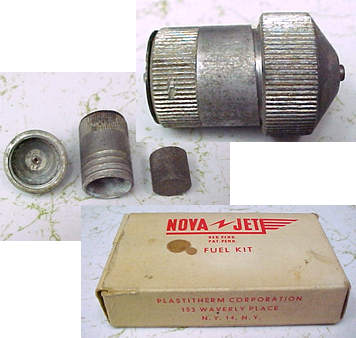Nova Jet — Austrian simplicity

Jim Fackert, owner of the Nova-Jet motor pictured here,
says of it:
"The Nova-Jet apparently was a delta winged elastic catapult launched glider that optionally flew with a Jetex-like engine [pictured].
I have the engine and some fuel pellets, but no airplane, and no pictures of it. "The fuel pellets were made in Germany, and I suspect that the whole plane may have been made there…
"The engine is interesting in that it has a threaded-on nozzle and pressure relief port on the front with a dimpled disk spring that seals the port. It's a fairly hefty aluminum body with an acme threaded aluminum nozzle cap and a steel nozzle liner eyelet riveted in."
Jim asked:
"Has anybody ever seen the Nova-Jet aeroplane?"
... and Steve Lawrie sent us this reply:
FILLING THE JET ENGINE

- Insert the jet fuel pellet (b) all the way into the chamber (a).
- Push the fuse (e) through the jet nozzle (d) and bend it a little, do not break it, at the interior end as shown in the above diagram.
- Screw the cap (c) onto the chamber tightly to avoid gas leakage and push the extending fuse into the chamber so that approximately only 1/4 inch of the fuse protrudes from the jet nozzle. By this method, the fuse is assured perfect contact with the jet fuel, and false ignitions can be avoided.
- Light the fuse and launch the plane as described above.
"Back in the early 60's, I remember my dad bringing us back two of these planes from a business trip in Europe. We lived in Johannesburg, South Africa.
"My brother and I each were given a Nova-Jet in its box. I remember it as being made of white, fairly dense polystyrene foam and was definitely the first molded foam airplane we had ever seen. It was probably 9 inches long with a span only slightly smaller. It came with a hand-held catapult whose elastic sling you hitched to a catch under the nose.
The thing flew quite well (but lacked lateral stability) on the catapult alone. "I think that the motors were already mounted on the top middle section of the planes when we removed them from their boxes. I distinctly remember their shiny aluminium-like feel and appearance: just two parts, the chanmber and threaded nozzle.
The original package did not include any fuel pellets for these motors, but they worked with Jetex pellets."
Chris Krizek bought one in 1954 in Vienna from the Austrian aeromodelling supplies company Sperl (in the Wiedner Hauptstrasse, then in the British sector of Vienna). To his knowledge, Sperl were the makers of the Nova-Jet (or had it locally manufactured for them). The packaging mentioned no patents and had no other trade marks. As Chris recalls, “It was quite primitive and heavy and much cheaper than a Jetex unit but suited my financial status and the only fuel available were Jetex 50 pellets.”

